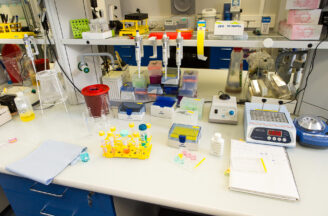Obsah stránky
Aktuálně z laboratoře
Experimentální laboratoř intenzivní medicíny je od roku 2004 jedna ze základních platforem Biomedicínského centra. Představuje komplexně vybavené experimentální pracoviště věrně simulující prostředí intenzivní péče, včetně náhrady orgánových funkcí. Hlavním dlouhodobým cílem výzkumu je objasňování mechanismů multiorgánového selhání v sepsi a septickém šoku s identifikací a testováním nových léčebných metod a cílů, a to za využití klinicky relevantních animálních experimentů s translačním potenciálem a reálným dopadem na klinickou praxi. Dlouhodobě přitom spolupracujeme s laboratořemi antibiotické rezistence a experimentální kardiologie.
Dlouhodobé výzkumné cíle
- Objasnění etiopatogeneze akutního (multi)orgánového poškození v kritických stavech, zejména v septickém šoku.
- Identifikace a testování nových léčebných cílů a molekul v léčbě život ohrožujících infekcí.
- Testování účinnosti, bezpečnosti a analýza mechanismů nových metod náhrady a podpory orgánových funkcí.
Aktuální výzkum
V současném roce pokračujeme v dlouhodobém projektu zkoumajícím vliv námi konstruované molekuly obsahující anti-sense oligonukleotid cílící na gen syntézy bakteriální stěny a efekt této intervence v modulaci virulence a rezistence vůči antibiotikům v terénu sepse a septického šoku. Výzkum navazuje na pilotní studii z minulého roku a jeho dokončení je naplánováno na podzim 2025.
Tým
prof. MUDr. Martin Matějovič, Ph.D. – vedoucí výzkumného programu
prof. MUDr. Jan Beneš, Ph.D.
MUDr. Jiří Müller – vedoucí laboratoře
MUDr. Mgr. Jan Horák, PhD.
MUDr. Václav Tégl
MUDr. Lukáš Nalos, Ph.D.
MUDr. Pavel Vintrych
Bc. Hanzlíková Miroslava
Bc. Jánská Karin
Publikace a spolupráce
Nejvýznamnější publikace a spolupráce laboratoře v průběhu let
| 2024 | Tegl, V. et al. (2024) “Ineffectiveness of hemoadsorption in large animals with abdominal sepsis: a randomized controlled porcine study,” Intensive care medicine experimental https://doi.org/10.1186/s40635-024-00622-x |
| 2023 | Vintrych, P. et al. (2023) “Modeling sepsis, with a special focus on large animal models of porcine peritonitis and bacteremia,” Frontiers in physiology https://doi.org/10.3389/fphys.2022.1094199 |
| 2022 | Chalupova, M. et al. (2022) “Gut microbiome diversity of porcine peritonitis model of sepsis,” Scientific reports https://doi.org/10.1038/s41598-022-21079-6 |
| 2020 | Chvojka, J. et al. (2020) “Mechanical circulatory support in refractory vasodilatory septic shock: A randomized controlled porcine study,” Shock https://doi.org/10.1097/shk.0000000000001329 Horak, J. et al. (2020) “Evaluation of mesenchymal stem cell therapy for sepsis: A randomized controlled porcine study,” Frontiers in imunology https://doi.org/10.3389/fimmu.2020.00126 |
| 2019 | Kohoutova, M. et al. (2019) “Vagus nerve stimulation attenuates multiple organ dysfunction in resuscitated porcine progressive sepsis,” Critical care medicine https://doi.org/10.1097/ccm.0000000000003714 |
| 2018 | Jarkovska, D. et al. (2018) “Cellular mechanisms of myocardial depression in porcine septic shock,” Frontiers in physiology https://doi.org/10.3389/fphys.2018.00726 |
| 2017 | Matejovic, M. et al. (2017) “Molecular differences in susceptibility of the kidney to sepsis-induced kidney injury,” BMC nephrology https://doi.org/10.1186/s12882-017-0602-x Jarkovska, D. et al. (2017) “Heart-rate variability depression in porcine peritonitis-induced sepsis without organ failure,” Experimental biology and medicine https://doi.org/10.1177/1535370217700521 |
| 2016 | Jarkovska, D. et al. (2016) “Heart rate variability in porcine progressive peritonitis-induced sepsis,” Frontiers in physiology https://doi.org/10.3389/fphys.2015.00412 Matejovic, M. et al. (2016) “Renal proteomic responses to severe sepsis and surgical trauma: Dynamic analysis of porcine tissue biopsies,” Shock https://doi.org/10.1097/shk.0000000000000613 Tuma, Z. et al. (2016) “Mitochondrial proteomes of porcine kidney cortex and medulla: foundation for translational proteomics,” Clinical and experimental nephrology https://doi.org/10.1007/s10157-015-1135-x |
| 2013 | Stengl, M. et al. (2013) “Effects of clinically relevant acute hypercapnic and metabolic acidosis on the cardiovascular system: an experimental porcine study,” Critical care https://doi.org/10.1186/cc13173 |
| 2011 | Benes, J. et al. (2011) “Searching for mechanisms that matter in early septic acute kidney injury: an experimental study,” Critical care https://doi.org/10.1186/cc10517 Krouzecky, A. et al. (2011) “The safety and efficacy of a new anticoagulation strategy using selective in-circuit blood cooling during haemofiltration–an experimental study,” Nephrology, dialysis, transplantation: official publication of the European Dialysis and Transplant Association – European Renal Association https://doi.org/10.1093/ndt/gfq622 Kuncová, J. et al. (2011) “Plasma and tissue levels of neuropeptide Y in experimental septic shock: Relation to hemodynamics, inflammation, oxidative stress, and hemofiltration,” Artificial organs https://doi.org/10.1111/j.1525-1594.2010.01154.x Kuncová, J. et al. (2011) “Tissue concentrations of vasoactive intestinal peptide are affected by peritonitis-induced sepsis and hemofiltration in pigs,” Physiological research https://doi.org/10.33549/physiolres.932051 |
| 2010 | Stengl, M. et al. (2010) “Differential effects of hemofiltration and of coupled plasma filtration adsorption on cardiac repolarization in pigs with hyperdynamic septic shock,” Shock https://doi.org/10.1097/shk.0b013e3181ab6359 Stengl, M. et al. (2010) “Reduced L-type calcium current in ventricular myocytes from pigs with hyperdynamic septic shock,” Critical care medicine https://doi.org/10.1097/ccm.0b013e3181cb0f61 |
| 2009 | Sykora, R. et al. (2009) “Coupled plasma filtration adsorption in experimental peritonitis-induced septic shock,” Shock https://doi.org/10.1097/shk.0b013e318188dec5 Sykora, R. et al. (2009) “High versus standard-volume haemofiltration in hyperdynamic porcine peritonitis: effects beyond haemodynamics?,” Intensive care medicine https://doi.org/10.1007/s00134-008-1318-y Krouzecky, A. et al. (2009) “Regional cooling of the extracorporeal blood circuit: a novel anticoagulation approach for renal replacement therapy?,” Intensive care medicine https://doi.org/10.1007/s00134-008-1271-9 |
| 2008 | Stengl, M. et al. (2008) “Continuous hemofiltration in pigs with hyperdynamic septic shock affects cardiac repolarization,” Critical care medicine https://doi.org/10.1097/ccm.0b013e31818f9eda Chvojka, J. et al. (2008) “Renal haemodynamic, microcirculatory, metabolic and histopathological responses to peritonitis-induced septic shock in pigs,” Critical care https://doi.org/10.1186/cc7164 |
| 2007 | Matejovic, M. et al. (2007) “Effects of combining inducible nitric oxide synthase inhibitor and radical scavenger during porcine bacteremia,” Shock https://doi.org/10.1097/01.shk.0000235088.53421.6f |
| 2006 | Kroužecký, A. et al. (2006) “Perfusion pressure manipulation in porcine sepsis: effects on intestinal hemodynamics,” Physiological research https://doi.org/10.33549/physiolres.930821 |
| 2005 | Matejovic, M. et al. (2005) “Effects of tempol, a free radical scavenger, on long-term hyperdynamic porcine bacteremia,” Critical care medicine https://doi.org/10.1097/01.ccm.0000162927.94753.63 |
| 2004 | Matejovic, M. et al. (2004) “Selective inducible nitric oxide synthase inhibition during long-term hyperdynamic porcine bacteremia,” Shock https://doi.org/10.1097/00024382-200405000-00010 |
Kontakt:
MUDr. Jiří Müller
T: 377 103 165
E: mullerji@fnplzen.cz

